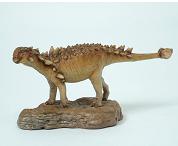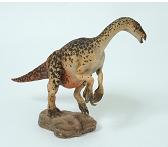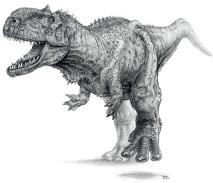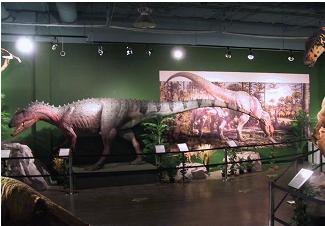
Scientists Find New Meat-Eating Dinosaur Bigger Than T-Rex...
Scientists working in Argentina have announced the discovery of a new, large, meat-eating dinosaur that was even larger than Tyrannosaurus rex. Furthermore, researchers believe the animal may have hunted its prey in packs.
The fossilized remains of the new dinosaur were estimated to be 100 million years old. Scientists found approximately seven skeletons ranging in size from between 18 feet to 40 feet long. They called the new species Mapusaurus roseae. The discovery was reported in the French scientific journal 'Geodiversitas.'
Scientists working in Argentina have announced the discovery of a new, large, meat-eating dinosaur that was even larger than Tyrannosaurus rex. Furthermore, researchers believe the animal may have hunted its prey in packs.
The fossilized remains of the new dinosaur were estimated to be 100 million years old. Scientists found approximately seven skeletons ranging in size from between 18 feet to 40 feet long. They called the new species Mapusaurus roseae. The discovery was reported in the French scientific journal 'Geodiversitas.'


Model Kits Now Available
We now have complete model, size, scale, and pricing information available on our popular Model Kits. These kits are shipped unpainted for you to put together yourself. Save and learn about your favorite dinosaurs with a CM Studio Model Kit!
See our CM Studio Model Kits page here
We now have complete model, size, scale, and pricing information available on our popular Model Kits. These kits are shipped unpainted for you to put together yourself. Save and learn about your favorite dinosaurs with a CM Studio Model Kit!
See our CM Studio Model Kits page here
Dinosaur Exhibits
One of CM Studio's recently completed installation. .
click images for larger views
See all of our life-size dinosaurs here
One of CM Studio's recently completed installation. .
click images for larger views
See all of our life-size dinosaurs here
Above: Great panoramic exhibit photo.
CM Studio's life-size sculptures come to life. Here we see an Allosaurus.
Another photo of the historical and
educational exhibit.

The fact that seven animals were found together of varying sizes and ages was one reason scientists believed Mapusaurus roseae may have hunted in packs. Paleontologist Philip Currie, of Canada's University of Alberta told the 'Washington Post,' 'It's certainly an intriguing idea.'
Currie said that the Mapusaurus roseae may have been able to hunt the largest land animal ever to walk the earth, the 100-ton Argentinosaur which grew to as long as 125-feet long.
'Whatever they could cut out, they would go after,' Currie explained. 'They were really bulky animals, but Argentinosaurs were even slower. You only have to be faster than whatever you're chasing.'
The group of fossils found in the Patagonian forest may have been done in by a flash flood or some other sudden event. 'The river was running very fast when they were buried in it,' Currie said. 'It was a single event in a short amount of time.'
Like T-rex, Mapusaurs were large, bulky predators that walked on their hind legs and used their teeth to kill prey. There were some significant differences, according to Currie. 'Mapusaurs have long, thin skulls with knifelike teeth and jaws that can close very fast,' Currie said. 'T. rex has a short skull with powerful, banana-shaped teeth better for biting through bone.'
Scientists are hopeful they can find additional Mapasaur specimens in the future that will tell them more about this giant predator.
Currie said that the Mapusaurus roseae may have been able to hunt the largest land animal ever to walk the earth, the 100-ton Argentinosaur which grew to as long as 125-feet long.
'Whatever they could cut out, they would go after,' Currie explained. 'They were really bulky animals, but Argentinosaurs were even slower. You only have to be faster than whatever you're chasing.'
The group of fossils found in the Patagonian forest may have been done in by a flash flood or some other sudden event. 'The river was running very fast when they were buried in it,' Currie said. 'It was a single event in a short amount of time.'
Like T-rex, Mapusaurs were large, bulky predators that walked on their hind legs and used their teeth to kill prey. There were some significant differences, according to Currie. 'Mapusaurs have long, thin skulls with knifelike teeth and jaws that can close very fast,' Currie said. 'T. rex has a short skull with powerful, banana-shaped teeth better for biting through bone.'
Scientists are hopeful they can find additional Mapasaur specimens in the future that will tell them more about this giant predator.
Lebanese soil gives up dinosaur teeth
Palaeontologists have uncovered the first dinosaur remains in Lebanon, adding evidence to the theory that millions of years ago the Middle East was covered with forests where giant reptiles roamed.
Palaeontologists have uncovered the first dinosaur remains in Lebanon, adding evidence to the theory that millions of years ago the Middle East was covered with forests where giant reptiles roamed.
A stocky, carnivorous dinosaur with an unusual head crest has been identified from bones collected in India. American and Indian scientists, working with support from the National Geographic Society, have named the animal Rajasaurus narmadensis.

More new finds!
Dinosaur Discovered in Patagonia-Named "Small Head"
Argentine paleontologists have discovered a 13-foot (4-meter) plant-eating dinosaur with a long neck and small head that roamed the southern tip of South America about 70 million years ago.



